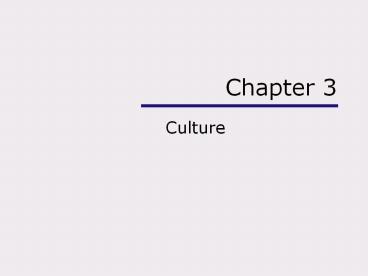Culture PowerPoint PPT Presentation
Title: Culture
1
Chapter 3
- Culture
2
Chapter Outline
- Using the Sociological Imagination
- Dimensions of Culture
- Language and Culture
- Cultural Diversity and Similarity
- Culture, Society, and Heredity
3
Premarital Sexual Experience Among Teen Women in
the U.S.
4
Culture and Society
- Culture consists of material objects and patterns
of thinking, feeling, and behaving passed from
generation to generation. - A society is a group of people living within
defined territorial borders who share a culture.
5
Categories of Culture
- Normative - composed of norms, sanctions, and
values. - Cognitive - language, beliefs
- Material - concrete, tangible aspects of a
culture
6
Norms
- Rules defining appropriate and inappropriate ways
of behaving. - Sanctionspositive and negative, formal and
informal are used to encourage conformity to
norms.
7
Dos and Taboos Around the World
Bulgaria A nod means no, and a shake of the head from side to side means yes.
Great Britain Never touch the Queen and dont offer to shake her hand unless she extends her hand to you first
Germany Shaking hands while your other hand is in your pocket is considered impolite.
8
Dos and Taboos Around the World
Greece The Greeks do not respect lines, or queues, in public places.
Italy Italians consider it unfeminine for a woman to pour wine.
Russia Whistling at public gatherings is a sign of disagreement and disapproval.
9
American Values
- Achievement and success
- Activity and work
- Efficiency and practicality
- Equality
- Democracy
- Group (racial, ethnic, religious) Superiority
10
Theoretical Perspectives Culture
Theoretical Perspective Aspect of Culture
Functionalism The norm requiring students to listen to their teachers on request.
Conflict theory Drug use by a member of a drug subculture
Symbolic interactionism Confederate flag on the back window of a truck
11
Symbols Created for Internet Communication
-) Happy -P Tongue in cheek
-) Winking UOK? Are you OK?
-( Sad B Be
-D Laughing B4 Before
-O Surprised BBL Be back later
-_at_ Screaming BRB Be right back
12
Symbols Created for Internet Communication
BTW By the way LUV Love
XLNT Excellent NO1 No on
4 For, Four OIC Oh, I see
GR8 Great PLS Please
L8R Later PCM Please call me
LOL Laughing out loud C See
13
Symbols Created for Internet Communication
THX Thanks WAN2 Want to
TTUL Talk to you later ? What
2 Too, to, two U You
2DAY Today YR Your
2MORO Tomorrow
14
Gun Control
15
Subcultures Southern Appalachia
- According to sociologists in the 1960s
- Southern Appalachians are fatalistic, present
oriented, unambitious, and nonparticipative. - The subculture is a cultural adaptation to living
a long-standing deprived and frustrating
existence.
16
Countercultures
- A subculture that is deliberately opposed to
aspects of the dominant culture. - Openly defy norms, values, and beliefs of the
dominant culture. - Rebelling against the dominant culture is central
to their members. - Examples
- militia movement, skinheads
17
Patterns of Tourism
18
A Comparison of Values Among Arabs and Americans
Value Arab Rank American Rank
Self-respect 1 2
Good health and hygiene 2 3
Responsibility 3 1
Respect for elders 4 5
Achieve a better life 5 8
Self-reliance 6 4
19
A Comparison of Values Among Arabs and Americans
Value Arab Rank American Rank
Religion faith 7 12
Serious work habits 8 6
Obedience 9 11
Creativity 10 9
Tolerance of others 11 10
Respect for authority 12 7
20
Cultural Diversity
- Because humans are basically the same
biologically, cultural diversity must be
explained by nongenetic factors. - Cultural diversity within societies is promoted
by social categories, subcultures, and
countercultures.
21
Cultural Universals
- Found in all societies but their expression
varies among societies. - Reasons for cultural universals
- Biological similarity of humans
- Common limitations of the physical environment
- Common problems of sustaining social life
22
Cultural Universals
23
Human Instincts
- Humans do not have instincts, human behavior is
learned. - Genetically inherited drives do not determine how
humans behave, because people are heavily
influenced by culture.

